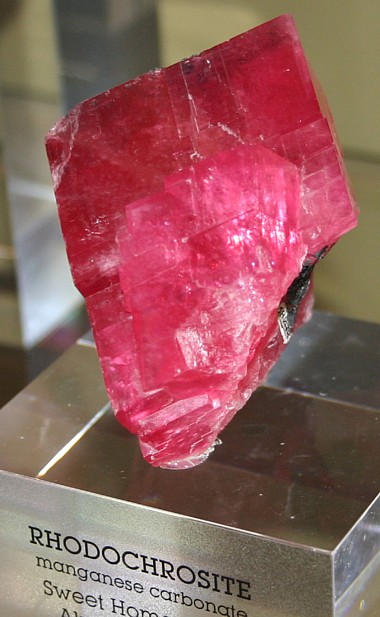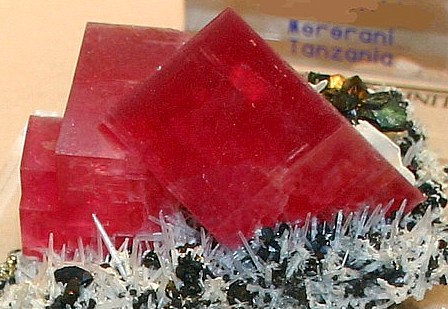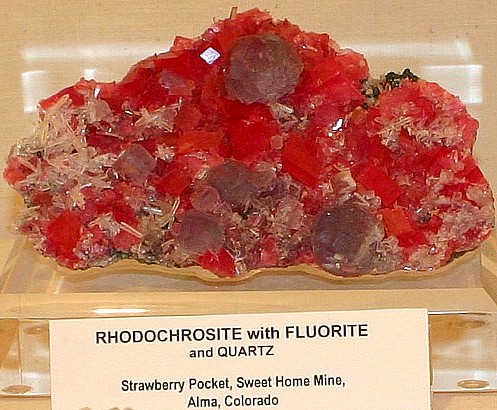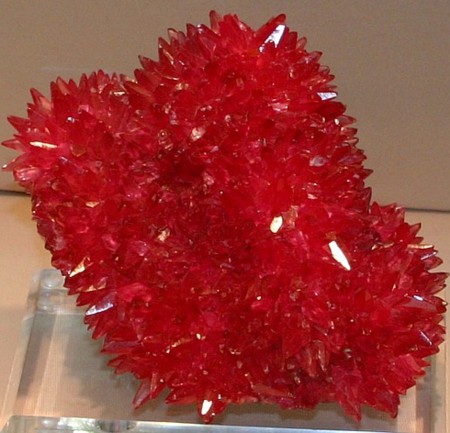|
Rhodochrosite Mineral Facts:
Chemical Formula: MnCO3
Manganese Carbonate 61.7% Manganese Oxide by weight.Both Ca and Fe
substitute in the crystal for Mn.
Colors:
Various shades of pink to
rose red, yellowish-grey,and brownish. Streak is white.
Hardness: 4
Density: 3.55
Cleavage:
Three
perfect cleavages parallel
to the faces of the rhombohedron in all three directions.
The mineral is brittle.
Crystallography:
Rhombohedral
Luster:.
Vitreous, inclining to
pearly; translucent to subtranslucent.
Optics:
(Refractive Index): w = 1.816; e = 1.597
|
 |
|
Composition,
Structure and Associated Minerals:
Rhodochrosite
sometimes occurs in distinct crystals of a rose-red color; but it is usually
found in cleavable masses, in a compact form, or as a granular aggregate.
Sometimes it is in incrustations. It is not of commercial importance in
North America.
Rhodochrosite is a
comparatively rare mineral, occurring in veins with ores of silver, lead and
copper, and with other manganese minerals. Occurs as a gangue stone in lead
and silver lead ore veins; it also occurs as a metasomatic replacement of
limestones.
Identification and Diagnostics
There are but few
minerals resembling pure rhodochrosite in appearance. From all of
these, except the silicate,
rhodonite, it is distinguished by its reaction
for manganese. It is distinguished from rhodonite by its hardness, its
cleavage and its effervescence with acids. It is soluble in hot hydrochloric
acid with effervescence. The impure varieties are very like some forms of
siderite, from which, of course, the manganese test will distinguish it.
Occurrence,
Localities and Origins:
Rhodochrosite occurs in veins associated with
ores of silver, lead, copper
and other manganese ores and in bedded deposits. It is the result of
hydrothermal or contact metamorphism, and of weathering of other manganese
bearing minerals. The mineral is found at Schemnitz, in Hungary; at Nagyag,
in Transylvania; at Glendree, County Clare, Ireland, where it forms a bed
beneath a bog. A beautiful pink and white banded form is mined in Argentina.
In the US at Washington, Conneticut, in a pulverulent form; at
Franklin, N. J. ; at the John Reed Mine, Aliconte, Lake Co., and at Rico,
Colo.; at Butte City, Mont.; at
Austin, Nevada, and on Placentia Bay,
Newfoundland. The Colorado and Montana specimens are often showy and well
crystallized. Uses. The mineral is mined with other ores of manganese.
Occasionally, it its most perfect forms it is employed as a gem stone, both
as a cabochon and as a faceted gem.
Return to the
Mineral Collectors Information Page |

|
|






